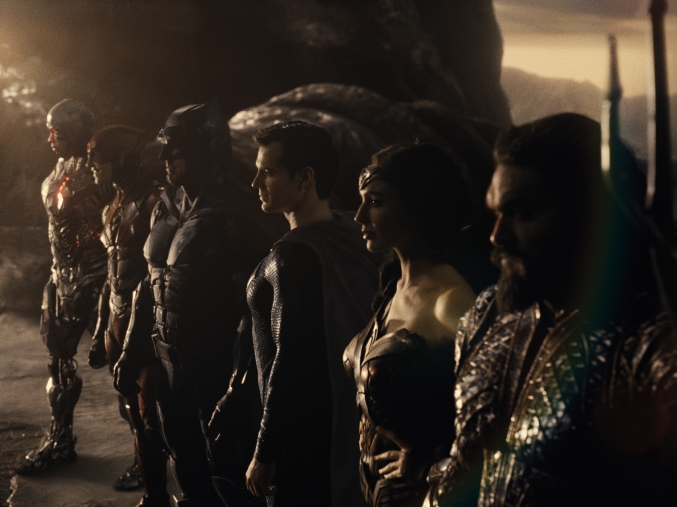
Directed by Zack Snyder — Screenplay by Chris Terrio — Story by Chris Terrio, Zack Snyder, and Will Beall.
In 2017, Warner Bros. released the film titled Justice League in theaters worldwide. This was a superhero team-up film that was supposed to be the third installment in a series of films set in Warner Bros.’ cinematic universe that has been dubbed the DC Extended Universe. The previous two installments — Man of Steel and Batman v Superman — were directed by Zack Snyder, who had essentially become the godfather, or the face, of the DC Extended Universe.
Snyder was also supposed to complete Justice League, but, due to a family tragedy, he decided to step away from the film and let Joss Whedon, the seasoned superhero filmmaker hired by Warner Bros. to replace him, finish the film. But Whedon and Snyder are very different filmmakers and they have different sensibilities, and, ultimately, the theatrical cut of Justice League was met with largely negative reviews. The final product lacked a uniform vision and tone, and it started to become clear that a lot of the essential material that Zack Snyder had planned for the film had been left on the cutting room floor.
But the most ardent fans of these films would not let those scenes be forgotten. As time went on, more and more rumors and reports suggested that there was a better film out there. Indeed, fans started a movement that demanded that Warner Bros. should release Zack Snyder’s version of the film. It wouldn’t be a remake, and it wouldn’t just be a traditional extended cut. In theory, this alternate cut would be divorced from the corrections that were supposedly made by a committee via Joss Whedon in the wake of Zack Snyder’s departure from the film during post-production. This cut of the film would supposedly not include any shot from Joss Whedon’s reshoots. In the end, Warner Bros. gave in and accepted the demands and provided Snyder with a new budget to oversee new scenes, add visual effects, improve the main villain’s character design, and more. And now it’s here.
This week Warner Bros. released the so-called Snyder Cut on HBO Max (and on HBO Nordic in my territory) and it now goes by the name of Zack Snyder’s Justice League. With a runtime of 242 minutes, it is approximately two hours longer than the theatrical cut. There are new scenes, extended subplots, plenty of cameo appearances, title cards that divide the film up into different chapters, and the entire film is presented in a 1.33:1 aspect ratio for the purpose of ‘preserving Zack Snyder’s vision.’ But, when it comes down to it, it is still the same story that you’re watching, except for the fact that the film’s main villain — Steppenwolf (voiced by Ciarán Hinds) — feels more like a henchman in the Snyder Cut due to the addition of multiple scenes with the iconic DC Comics villain, Darkseid (played by Ray Porter).
Therefore, like in the other cut, Zack Snyder’s Justice League takes place after the events of Batman v Superman: Dawn of Justice. With Superman (played by Henry Cavill) having died in the previous film, both Wonder Woman — Diana Prince (played by Gal Gadot) — and Batman — Bruce Wayne (played by Ben Affleck) — are looking for other super-powered individuals to help them protect Earth. In the film, we see them try to recruit The Flash (Barry Allen, played by Ezra Miller), Aquaman (Arthur Curry, played by Jason Momoa), and Cyborg (Victor Stone, played by Ray Fisher).
Meanwhile, Steppenwolf — a powerful alien — has brought these winged creatures — the so-called ‘Parademons’ — with him to Earth, since it is no longer being defended by a Kryptonian, and he is hellbent on finding three so-called ‘Mother Boxes’ that ages ago were split between the Amazons, Atlanteans, and the humans for the purpose of earning the confidence of Darkseid, who wants to conquer Earth.
Regardless of whether or not you are a fan of his style, Zack Snyder’s Justice League showcases the director at both his best and his worst. Throughout the film, we see these beautiful shots depicting larger-than-life characters living up to Snyder’s understanding of them, which often means that they are presented as mythic godlike saviors and that they may be framed in a way that resembles religious imagery.
Snyder sees the ‘Justice League’ as a pantheon of heroes, and he enjoys watching them in all their glory as they make their moves. However, this also often means that he uses a lot of slow-motion shots, which is, indeed, the case with this film. Not all of the slow-motion shots are necessary (or make sense), but this is his directing style and it is often paired with a dark tone and dark color palette, which, of course, means that the Snyder Cut drains the film of all of the artificial (and sometimes reddish and ugly) colors that dominated the theatrical cut.
With Man of Steel and Batman v Superman: Dawn of Justice, Zack Snyder made it clear that, in his vision of these films, heroes break the classic comic book rule of not killing villains. This means that the heroes are often violent and this is also true of the Snyder Cut. In this film, a character is even decapitated by one of the heroes. However, it should be noted that even though Zack Snyder’s Justice League has the dark and grim visual aesthetic that the theatrical cut abandoned, there is still a surprising amount of humor here.
However, this version of the film probably won’t win over new fans, in part, due to the intimidating 4-hour runtime, but also because, even though the Snyder Cut is ultimately more coherent than the theatrical cut, it is also bloated and self-indulgent. For example, the film relies on an excessive amount of slow-motion shots, and some shots just, in general, go on for too long. It also doesn’t help that a new version of Wonder Woman’s theme — now involving an ‘Amazon yell’ — plays so many times over the course of the film that it feels like placeholder music or a drinking game.
I think we also have to talk about the idea that it may not be fair to compare the current state of the Snyder Cut to the theatrical cut since it is essentially a glorified (but completed) assembly cut of the film that never would’ve made it to theaters in the first place as a single movie. When Warner Bros. provided Snyder with a new budget of $70 million to complete his assembly cut, it was pretty much a given that more superhero ‘content’ would be well-received by fans.
But while the assembly cut does allow for more moments of superhero interactions and whatnot, the amount of content is not the basis for an evaluation of a movie. The movie doesn’t get a score based on how many heroes are in it, or how many dangling plot threads and easter eggs that we like. I think you should evaluate a movie on a different set of criteria. In a way, a comparative review, which most reviews of this film will lean towards, is somewhat unfair because such a review looks at the theatrical cut more than it looks at this version of the film as its own thing that is carving out its own space in the pop culture. Regardless of how I or others feel, I think it would always be easier to say that this cut is an improvement than it would be to say that it is a good movie.
This cut is undoubtedly a better movie than the one released by Warner Bros. in 2017. Of course, you might say. But throwing everything you have at a wall to see what sticks is not a tried and true method to achieving an improvement, as is evident by the overlong and cameo-heavy epilogue which, admittedly, does include a very intriguing (and completely new) scene even though most of the epilogue feels tacked-on (and the final scene is especially clumsy with unconvincing visual effects and dialogue). What I think makes this version much better is that it has a soul, a clear distinct vision, that the main characters’ interactions are much more natural, and that it actually lives up to the universe that was created prior to the 2017 film. The theatrical cut felt like a course correction — an overcorrection — whereas this feels like a continuation of the kind of aesthetic and tone that we had been promised.
This movie lives up to that promise and then some, which is to say that the movie is bloated, but also that the film is exactly what the fans ordered, which is just more. Again, make no mistake, this Snyder Cut would never have been released as the original product back in 2017. But I also think that there is a pretty great and memorable (approximately) three-hour comic book movie inside of this assembly cut. I think that if Warner Bros. had pushed the theatrical release date and given Snyder more time, then this could’ve been not just salvaged but a legitimate success at the get-go.
In the end, what I love the most about this cut of the film is the fact that it restores certain subplots — involving Ray Fisher and Ezra Miller — that didn’t just feel missing back in 2017, but which actually make the film work much, much better now. Cyborg is the heart of this film — which is all about fathers, choosing your family, and choosing who you want to be — and the theatrical cut completely butchered his origin story, which this film was supposed to give us. Also, the Flash has a moment during the final battle that is legitimately one of the best superhero moments in any of Snyder’s films. The first time I watched this scene, my jaw dropped, my eyes opened wide, and I became wide awake out of pure comic book joy, and I am shocked that whoever was in charge of the theatrical cut replaced that moment with a scene where the Flash awkwardly says: “Dostoevsky,” as a farewell to civilians that he saves.
Although the idea of releasing what is essentially an assembly cut with completed visual effects is an odd experiment, I have to say that I actually really enjoyed watching this cut of the movie more than I thought I would. Zack Snyder’s vision of this cinematic universe (and his understanding of these characters) has never really aligned with what I would ideally want from these films. But I have to say that I loved that this cut of the film provided us with better character relationships, fleshed out and necessary subplots, and a uniform visual aesthetic and tone. With Zack Snyder’s Justice League, the original director has restored the heart to this superhero epic, which is nevertheless self-indulgent and overlong. It won’t be everyone’s cup of tea, and that is perfectly okay. But, hopefully, it provides the good-hearted part of the fanbase that helped make this happen with the film that they wanted to see. In any case, while it may have an unfair advantage over the theatrical cut, the Snyder Cut is a clear and obvious improvement on the original cut of the film.
7 out of 10
– Review Written by Jeffrey Rex Bertelsen.

2 thoughts on “REVIEW: Zack Snyder’s Justice League (2021)”